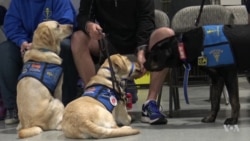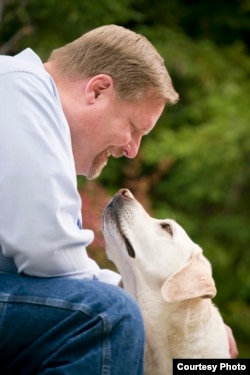Dogs can be trained to sniff out drugs and explosives, so Mark Ruefenacht wondered if their exquisite sense of smell could be used to detect changes in a diabetic’s blood sugar level.
A near fatal episode prompted the forensic scientist, who’s had diabetes for most of his adult life, to ask that question. In 1999, while he was training a puppy to be a guide dog for the blind, his blood sugar suddenly dropped to a dangerously low level.
“More than likely, I had a seizure, from the low blood sugar,” Ruefenacht recalled, as he explained how the puppy kept trying to rouse him. “And he stuck with me and I was able to get my blood sugar up.”
That incident made him wonder if dogs could be trained to detect the inherent chemical changes that accompany a drop in blood sugar, called hypoglycemia, then alert their owners.
Dogs4Diabetics
Ruefenacht worked with scientists and funded research which determined that the “smell” of hypoglycemia shows up in both breath and sweat. He also worked with and studied professionals who train dogs to sniff out everything from explosives to cancer. And most important of all, Ruefenacht started training a fun-loving yellow Labrador retriever named Armstrong to alert him when he was having a dangerously low blood sugar. The training proved so successful, Armstrong is listed in the Guinness Book of World Records as the first diabetes-detection dog.
Sitting under a poster of Armstrong, who died in 2012, Ruefenacht recalls that those early successes led some organizations to offer him large sums of money for the rights to his discoveries. Ruefenacht says he turned those opportunities down. Instead, in 2004, he founded Dogs4Diabetics.
He says properly training a diabetes detection dog and its owner can cost $50,000. The organization raises money to cover these expenses, then provides the dogs at no cost to people who qualify.
The smell of hypoglycemia
The dogs are trained to identify the scent of hypoglycemia on a reliable and consistent basis. Ruefenacht uses jars containing swabs of sweat from a diabetic who had low blood sugar, randomly mixed with jars of other distracting smells, such as peanut butter, dog food and eucalyputus. The dogs are rewarded when they select the correct jar. This "sweat jar" method for training diabetes alert dogs has been validated scientifically.
The next step is to teach them to alert their owner. The dogs are trained to use subtle signals, but if those go unnoticed, to put their paws on his lap, or balance on their back legs and put their front paws on his shoulders. They learn to snuffle at his nose and mouth, lick his face and bark. And if all else fails, they’re trained to get someone else to come and help.
Ruefenacht says the dogs are often aware of blood sugar drops long before electronic monitoring systems send a warning alarm.
Dogs4Diabetics has placed more than 100 dogs with diabetics. They hope to expand the program - training humanity's most loyal companion to save lives and help diabetics around the world.








